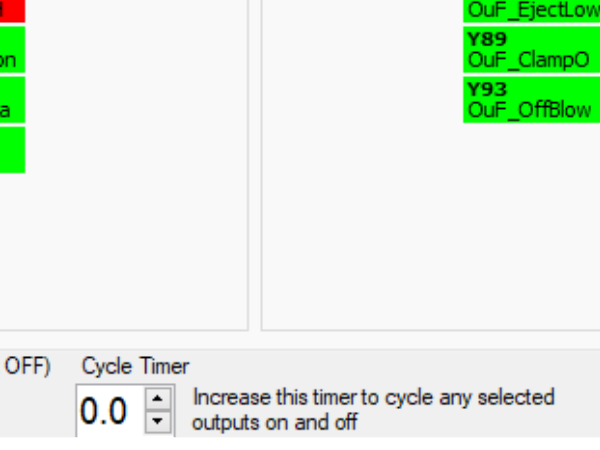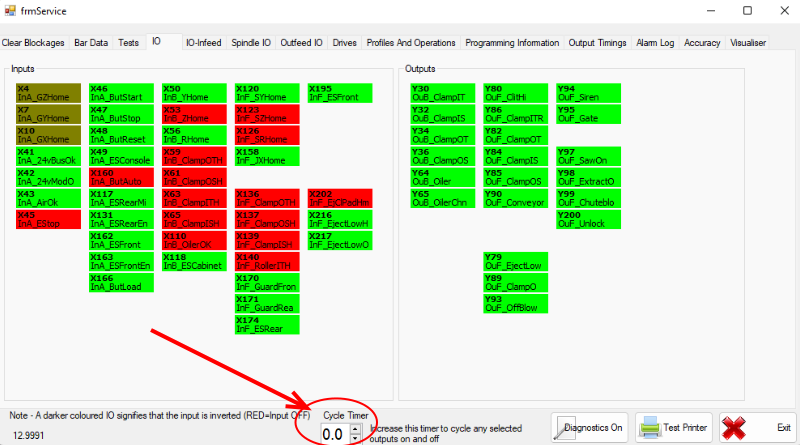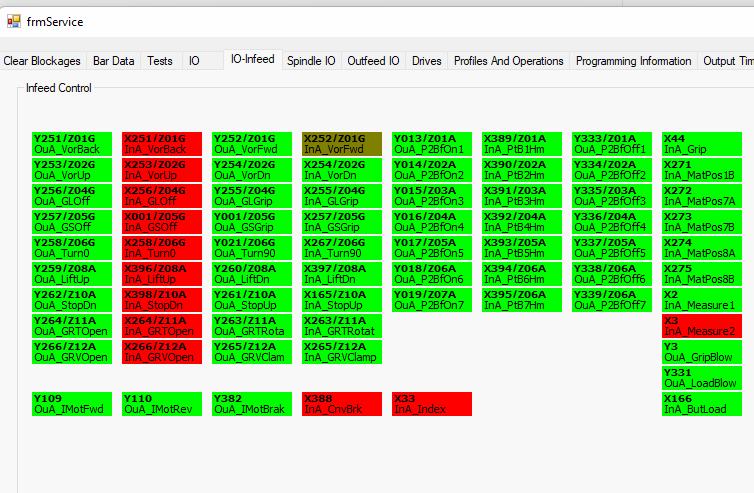| [version en cours de rédaction] | [version en cours de rédaction] |
(Page créée avec « {{Tuto Details |Description=<translate>Description of built in feature of IO screen to allow a maintenance operative to quickly and accurately adjust speed rates of cylind... ») |
|||
| Ligne 1 : | Ligne 1 : | ||
{{Tuto Details | {{Tuto Details | ||
| + | |Main_Picture=Cyclical_Control_of_Outputs_to_Aid_Cylinder_Speed_Setup_IO_Screen.png | ||
| + | |Main_Picture_annotation={"version":"2.4.6","objects":[{"type":"image","version":"2.4.6","originX":"left","originY":"top","left":-689,"top":-624,"width":988,"height":550,"fill":"rgb(0,0,0)","stroke":null,"strokeWidth":0,"strokeDashArray":null,"strokeLineCap":"butt","strokeDashOffset":0,"strokeLineJoin":"miter","strokeMiterLimit":4,"scaleX":1.93,"scaleY":1.93,"angle":0,"flipX":false,"flipY":false,"opacity":1,"shadow":null,"visible":true,"clipTo":null,"backgroundColor":"","fillRule":"nonzero","paintFirst":"fill","globalCompositeOperation":"source-over","transformMatrix":null,"skewX":0,"skewY":0,"crossOrigin":"","cropX":0,"cropY":0,"src":"https://stuga.dokit.app/images/b/be/Cyclical_Control_of_Outputs_to_Aid_Cylinder_Speed_Setup_IO_Screen.png","filters":[]}],"height":450,"width":600} | ||
|Description=<translate>Description of built in feature of IO screen to allow a maintenance operative to quickly and accurately adjust speed rates of cylinders</translate> | |Description=<translate>Description of built in feature of IO screen to allow a maintenance operative to quickly and accurately adjust speed rates of cylinders</translate> | ||
|Categories=Maintenance | |Categories=Maintenance | ||
}} | }} | ||
| − | <translate>= Problem = | + | <translate>=Problem= |
Setting the speed of a cylinder requires two people to do it effectively. One to operate the IO screen and one to adjust the speed | Setting the speed of a cylinder requires two people to do it effectively. One to operate the IO screen and one to adjust the speed | ||
| − | = Resolution = | + | =Resolution= |
The IO Service screens on winMulti have a Cycle Timer located at the bottom{{#annotatedImageLight:Fichier:Cyclical Control of Outputs to Aid Cylinder Speed Setup IO Screen.png|0=800px|hash=0c4ba378ddd803dbfaa06240efbafe65|jsondata={"version":"2.4.6","objects":[{"type":"image","version":"2.4.6","originX":"left","originY":"top","left":0,"top":0,"width":988,"height":550,"fill":"rgb(0,0,0)","stroke":null,"strokeWidth":0,"strokeDashArray":null,"strokeLineCap":"butt","strokeDashOffset":0,"strokeLineJoin":"miter","strokeMiterLimit":4,"scaleX":0.81,"scaleY":0.81,"angle":0,"flipX":false,"flipY":false,"opacity":1,"shadow":null,"visible":true,"clipTo":null,"backgroundColor":"","fillRule":"nonzero","paintFirst":"fill","globalCompositeOperation":"source-over","transformMatrix":null,"skewX":0,"skewY":0,"crossOrigin":"","cropX":0,"cropY":0,"src":"https://stuga.dokit.app/images/b/be/Cyclical_Control_of_Outputs_to_Aid_Cylinder_Speed_Setup_IO_Screen.png","filters":[]},{"type":"wfellipse","version":"2.4.6","originX":"center","originY":"center","left":336.26,"top":422.37,"width":81.53,"height":47.86,"fill":"rgba(255,0,0,0)","stroke":"#FF0000","strokeWidth":2,"strokeDashArray":null,"strokeLineCap":"butt","strokeDashOffset":0,"strokeLineJoin":"miter","strokeMiterLimit":4,"scaleX":1,"scaleY":1,"angle":0,"flipX":false,"flipY":false,"opacity":1,"shadow":null,"visible":true,"clipTo":null,"backgroundColor":"","fillRule":"nonzero","paintFirst":"fill","globalCompositeOperation":"source-over","transformMatrix":null,"skewX":0,"skewY":0,"rx":40.76682886268268,"ry":23.93244661813171},{"type":"wfarrow2line","version":"2.4.6","originX":"center","originY":"center","left":229,"top":369,"width":156,"height":78,"fill":"rgba(255,0,0,0)","stroke":"#FF0000","strokeWidth":4,"strokeDashArray":null,"strokeLineCap":"round","strokeDashOffset":0,"strokeLineJoin":"miter","strokeMiterLimit":4,"scaleX":1,"scaleY":1,"angle":0,"flipX":false,"flipY":false,"opacity":1,"shadow":null,"visible":true,"clipTo":null,"backgroundColor":"","fillRule":"nonzero","paintFirst":"fill","globalCompositeOperation":"source-over","transformMatrix":null,"skewX":0,"skewY":0,"x1":-78,"x2":78,"y1":-39,"y2":39,"x2a":63.68916494400135,"y2a":22.900310562001515,"x2b":56.533747416002015,"y2b":37.21114561800017},{"type":"wfarrow2circle","version":"2.4.6","originX":"center","originY":"center","left":151,"top":330,"width":16,"height":16,"fill":"#aaa","stroke":"#666","strokeWidth":0,"strokeDashArray":null,"strokeLineCap":"butt","strokeDashOffset":0,"strokeLineJoin":"miter","strokeMiterLimit":4,"scaleX":1,"scaleY":1,"angle":0,"flipX":false,"flipY":false,"opacity":0.5,"shadow":null,"visible":true,"clipTo":null,"backgroundColor":"","fillRule":"nonzero","paintFirst":"fill","globalCompositeOperation":"source-over","transformMatrix":null,"skewX":0,"skewY":0,"radius":8,"startAngle":0,"endAngle":6.283185307179586},{"type":"wfarrow2circle","version":"2.4.6","originX":"center","originY":"center","left":307,"top":408,"width":16,"height":16,"fill":"#aaa","stroke":"#666","strokeWidth":0,"strokeDashArray":null,"strokeLineCap":"butt","strokeDashOffset":0,"strokeLineJoin":"miter","strokeMiterLimit":4,"scaleX":1,"scaleY":1,"angle":0,"flipX":false,"flipY":false,"opacity":0.5,"shadow":null,"visible":true,"clipTo":null,"backgroundColor":"","fillRule":"nonzero","paintFirst":"fill","globalCompositeOperation":"source-over","transformMatrix":null,"skewX":0,"skewY":0,"radius":8,"startAngle":0,"endAngle":6.283185307179586}],"height":445,"width":800}|mediaClass=Image|type=frameless|align=center|src=/images/thumb/b/be/Cyclical_Control_of_Outputs_to_Aid_Cylinder_Speed_Setup_IO_Screen.png/ia-0c4ba378ddd803dbfaa06240efbafe65-px-Cyclical_Control_of_Outputs_to_Aid_Cylinder_Speed_Setup_IO_Screen.png.png|href=./Fichier:Cyclical Control of Outputs to Aid Cylinder Speed Setup IO Screen.png|resource=./Fichier:Cyclical Control of Outputs to Aid Cylinder Speed Setup IO Screen.png|caption=|size=800px}} | The IO Service screens on winMulti have a Cycle Timer located at the bottom{{#annotatedImageLight:Fichier:Cyclical Control of Outputs to Aid Cylinder Speed Setup IO Screen.png|0=800px|hash=0c4ba378ddd803dbfaa06240efbafe65|jsondata={"version":"2.4.6","objects":[{"type":"image","version":"2.4.6","originX":"left","originY":"top","left":0,"top":0,"width":988,"height":550,"fill":"rgb(0,0,0)","stroke":null,"strokeWidth":0,"strokeDashArray":null,"strokeLineCap":"butt","strokeDashOffset":0,"strokeLineJoin":"miter","strokeMiterLimit":4,"scaleX":0.81,"scaleY":0.81,"angle":0,"flipX":false,"flipY":false,"opacity":1,"shadow":null,"visible":true,"clipTo":null,"backgroundColor":"","fillRule":"nonzero","paintFirst":"fill","globalCompositeOperation":"source-over","transformMatrix":null,"skewX":0,"skewY":0,"crossOrigin":"","cropX":0,"cropY":0,"src":"https://stuga.dokit.app/images/b/be/Cyclical_Control_of_Outputs_to_Aid_Cylinder_Speed_Setup_IO_Screen.png","filters":[]},{"type":"wfellipse","version":"2.4.6","originX":"center","originY":"center","left":336.26,"top":422.37,"width":81.53,"height":47.86,"fill":"rgba(255,0,0,0)","stroke":"#FF0000","strokeWidth":2,"strokeDashArray":null,"strokeLineCap":"butt","strokeDashOffset":0,"strokeLineJoin":"miter","strokeMiterLimit":4,"scaleX":1,"scaleY":1,"angle":0,"flipX":false,"flipY":false,"opacity":1,"shadow":null,"visible":true,"clipTo":null,"backgroundColor":"","fillRule":"nonzero","paintFirst":"fill","globalCompositeOperation":"source-over","transformMatrix":null,"skewX":0,"skewY":0,"rx":40.76682886268268,"ry":23.93244661813171},{"type":"wfarrow2line","version":"2.4.6","originX":"center","originY":"center","left":229,"top":369,"width":156,"height":78,"fill":"rgba(255,0,0,0)","stroke":"#FF0000","strokeWidth":4,"strokeDashArray":null,"strokeLineCap":"round","strokeDashOffset":0,"strokeLineJoin":"miter","strokeMiterLimit":4,"scaleX":1,"scaleY":1,"angle":0,"flipX":false,"flipY":false,"opacity":1,"shadow":null,"visible":true,"clipTo":null,"backgroundColor":"","fillRule":"nonzero","paintFirst":"fill","globalCompositeOperation":"source-over","transformMatrix":null,"skewX":0,"skewY":0,"x1":-78,"x2":78,"y1":-39,"y2":39,"x2a":63.68916494400135,"y2a":22.900310562001515,"x2b":56.533747416002015,"y2b":37.21114561800017},{"type":"wfarrow2circle","version":"2.4.6","originX":"center","originY":"center","left":151,"top":330,"width":16,"height":16,"fill":"#aaa","stroke":"#666","strokeWidth":0,"strokeDashArray":null,"strokeLineCap":"butt","strokeDashOffset":0,"strokeLineJoin":"miter","strokeMiterLimit":4,"scaleX":1,"scaleY":1,"angle":0,"flipX":false,"flipY":false,"opacity":0.5,"shadow":null,"visible":true,"clipTo":null,"backgroundColor":"","fillRule":"nonzero","paintFirst":"fill","globalCompositeOperation":"source-over","transformMatrix":null,"skewX":0,"skewY":0,"radius":8,"startAngle":0,"endAngle":6.283185307179586},{"type":"wfarrow2circle","version":"2.4.6","originX":"center","originY":"center","left":307,"top":408,"width":16,"height":16,"fill":"#aaa","stroke":"#666","strokeWidth":0,"strokeDashArray":null,"strokeLineCap":"butt","strokeDashOffset":0,"strokeLineJoin":"miter","strokeMiterLimit":4,"scaleX":1,"scaleY":1,"angle":0,"flipX":false,"flipY":false,"opacity":0.5,"shadow":null,"visible":true,"clipTo":null,"backgroundColor":"","fillRule":"nonzero","paintFirst":"fill","globalCompositeOperation":"source-over","transformMatrix":null,"skewX":0,"skewY":0,"radius":8,"startAngle":0,"endAngle":6.283185307179586}],"height":445,"width":800}|mediaClass=Image|type=frameless|align=center|src=/images/thumb/b/be/Cyclical_Control_of_Outputs_to_Aid_Cylinder_Speed_Setup_IO_Screen.png/ia-0c4ba378ddd803dbfaa06240efbafe65-px-Cyclical_Control_of_Outputs_to_Aid_Cylinder_Speed_Setup_IO_Screen.png.png|href=./Fichier:Cyclical Control of Outputs to Aid Cylinder Speed Setup IO Screen.png|resource=./Fichier:Cyclical Control of Outputs to Aid Cylinder Speed Setup IO Screen.png|caption=|size=800px}} | ||
| − | * If an output is set to on, then the cycle timer increased to a value, the output will cycle on and off at the rate indicated in seconds. This is really useful to accurately set the speed of a cylinder. | + | *If an output is set to on, then the cycle timer increased to a value, the output will cycle on and off at the rate indicated in seconds. This is really useful to accurately set the speed of a cylinder. |
| − | * Multiple outputs can be set initially, and then all cylinders will fire simultaneously - really useful for setting popup cylinders and checking for air starvation | + | *Multiple outputs can be set initially, and then all cylinders will fire simultaneously - really useful for setting popup cylinders and checking for air starvation |
| + | {{Info|...Output cycling is only available in setup mode}}{{Info|...Reduce the cycle control back to zero to disable cycling}}<br /> | ||
| + | =Solenoid / Solenoid Valves= | ||
| − | + | * Some systems (eg Stuertz Infeed table) have "solenoid / solenoid" operated valves instead of the "standard "solenoid / spring" valves. This setup requires two signals / outputs for each valve, one for "out" and one for "home". These valves need a pulsed output to switch one way, then a separate output to fire back again. Unlike a sol / spring valve, the state is maintained on power off | |
| − | Some systems (eg Stuertz Infeed table) have "solenoid / solenoid" operated valves instead of the "standard "solenoid / spring" valves | + | * This situation makes testing and setting up more fiddly and complicated, and the need for the cycle control even more acute. Therefore this has been built in to versions front end 6.5.13.0 , back end 6.6001. |
| − | <br /></translate> | + | * This involves an update to the IODef file to define "Complimentary" outputs. See [[Mul File Specification - ioDef]] |
| + | * The cycle is activated in the same way - first select the output(s) to cycle and then increase the cycle timer | ||
| + | {{#annotatedImageLight:Fichier:Cyclical Control of Outputs to Aid Cylinder Speed Setup Infeed IO.png|0=754px|hash=|jsondata=|mediaClass=Image|type=frameless|align=center|src=https://stuga.dokit.app/images/6/64/Cyclical_Control_of_Outputs_to_Aid_Cylinder_Speed_Setup_Infeed_IO.png|href=./Fichier:Cyclical Control of Outputs to Aid Cylinder Speed Setup Infeed IO.png|resource=./Fichier:Cyclical Control of Outputs to Aid Cylinder Speed Setup Infeed IO.png|caption=|size=754px}}<br /></translate> | ||
{{PageLang | {{PageLang | ||
| + | |Language=en | ||
|SourceLanguage=none | |SourceLanguage=none | ||
|IsTranslation=0 | |IsTranslation=0 | ||
| − | |||
}} | }} | ||
{{AddComments}} | {{AddComments}} | ||
Version actuelle datée du 22 février 2023 à 20:02
Description of built in feature of IO screen to allow a maintenance operative to quickly and accurately adjust speed rates of cylinders
Problem
Setting the speed of a cylinder requires two people to do it effectively. One to operate the IO screen and one to adjust the speed
Resolution
The IO Service screens on winMulti have a Cycle Timer located at the bottom
- If an output is set to on, then the cycle timer increased to a value, the output will cycle on and off at the rate indicated in seconds. This is really useful to accurately set the speed of a cylinder.
- Multiple outputs can be set initially, and then all cylinders will fire simultaneously - really useful for setting popup cylinders and checking for air starvation
Solenoid / Solenoid Valves
- Some systems (eg Stuertz Infeed table) have "solenoid / solenoid" operated valves instead of the "standard "solenoid / spring" valves. This setup requires two signals / outputs for each valve, one for "out" and one for "home". These valves need a pulsed output to switch one way, then a separate output to fire back again. Unlike a sol / spring valve, the state is maintained on power off
- This situation makes testing and setting up more fiddly and complicated, and the need for the cycle control even more acute. Therefore this has been built in to versions front end 6.5.13.0 , back end 6.6001.
- This involves an update to the IODef file to define "Complimentary" outputs. See Mul File Specification - ioDef
- The cycle is activated in the same way - first select the output(s) to cycle and then increase the cycle timer
Draft



 Français
Français English
English Deutsch
Deutsch Español
Español Italiano
Italiano Português
Português